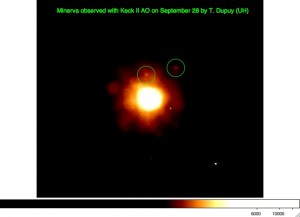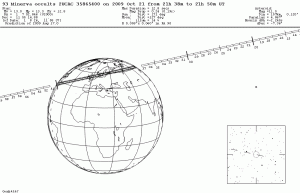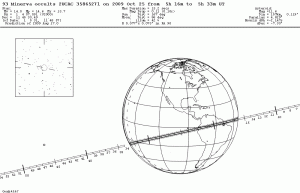Triple Asteroid (93) Minerva and future stellar occultations
Sponsoring my research. Any volunteers?
September 24, 2009Adopt a scientist program – The story in the news
October 15, 2009Hello,
Well I have not been very active on this blog for a month, I hope I did not disappoint you. The past 3 weeks have been extremely hectic with a lot of traveling and deadlines. I decided to summarize in several posts my recent activities per topic. Today I will talk about (93) Minerva, the triple system that we discovered in August.
(93) Minerva:
First of all, I continued my quest for more data for this triple asteroid to be able to determine the orbital parameters. I attended the Keck Science meeting where I met several Keck users including Trent Dupuy from University of Hawaii and Michael Busch from Caltech. Both are graduate students and they agreed to observe the triple system during their September nights. I received a few days ago, the observations taken by Trent that I am attaching below. The two moons are clearly visible. Michael promised to take data in November since they had some troubles during their September night. Thanks to both of them for considering helping us with this project.
During a brief visit at Observatoire de Paris, IMCCE, I discussed with my collaborators Pascal Descamps and Jerome Berthier. We initiated the orbit analysis and we should be able to predict roughly the positions of the satellites at the time of future stellar occultations. A stellar occultation (see explanation here) could be useful to determine accurately the size of the primary and the moonlets. One stellar occultation was observable on September 23 UT in Brazil, but the weather did not cooperate and Marcelo Assafin, astronomer at the Universidad Federal de Rio de Janeiro and his team could not collect any data at Pico dos Dias, Brazil.
Thankfully, several additional opportunities are predicted soon. The next one predicted on Oct 21 will be visible in northern part of Europe and will involve a star with magnitude 13. Four days later (Oct 25) another occultation will be visible from South America (star mv=14). I am attaching the predicted paths of these stellar occultations generated by Francois Colas from IMCCE/Observatoire de Paris using the Occult software.
There will be additional occultations in November 2009 and I will post them on this blog when the path is accurately predicted.
If you have access to a fast-read camera and a small telescope (30cm or more) you should be able to record the occultation. Even if you are located at less 1000 km away from the path of the occultation, it could be interesting to try to observe it since you may be able to detect an occultation by one of the satellites of the asteroid. The timing and the position are important for the data analysis, so it is necessary to have a GPS to measure your position and ideally calibrate the time to a tenth of second. Both stellar occultations are quite similar with a duration of 13s if you are on the path of the primary (and a drop of 0.1-0.2 magnitude) and less than 1s for the moonlets. Ideally we would like to predict in advance the positions of the satellites, but it may not be possible considering that we have only 5 astrometric positions so far. I will add some updates to this post in the future as soon we get some accurate predictions.
Clear skies
Franck M.






1 Comment
Wow,thanks for telling.I would be on this for October 21 onwards.Many of us don’t get this real time information that your have provided.Thanks again 🙂